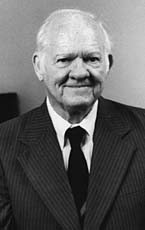Claude Wendell Horton, Sr (1915-2001)
 Claude Wendell Horton, Sr., age 86, died March 2, 2002. Horton was one of the principal contributors to the development of the Applied Research Laboratories and the Department of Physics at The University of Texas at Austin, and, between 1972-1975, he contributed significantly to the geophysics program in the Department of Earth and Planetary Sciences.
Claude Wendell Horton, Sr., age 86, died March 2, 2002. Horton was one of the principal contributors to the development of the Applied Research Laboratories and the Department of Physics at The University of Texas at Austin, and, between 1972-1975, he contributed significantly to the geophysics program in the Department of Earth and Planetary Sciences.
Horton was born in Cherryvale, Kansas, on September 23, 1915. From Rice Institute (now University) he received the B.A. degree (Honors) with a major in physics in 1935 and the M.A. degree in 1936. The following year he worked as an Assistant Seismologist for Shell Oil Company, a popular area of work for physicists at that time. This work marks the beginning of Horton’s interest in seismology and geology. During the 1937-38 school year he was a graduate student at Princeton University, but on November 23, 1938, he and Louise Charlotte Walthall were married and he returned to Shell Oil, this time as Party Chief, where he lead a group in exploration geology. He held this position until January 1943, when he resigned to undertake efforts in support of the war.
In May of 1943, following a brief stint as an Instructor in the Naval Training School at the University of Houston, Horton joined the staff of the Harvard Underwater Sound Laboratory as a Research Associate in Theoretical Physics. He remained at the Harvard Underwater Sound Laboratory until its closing at the end of the war in the summer of 1945. Dr. C. P. Boner, then Associate Director of the Harvard Underwater Sound Laboratory, recognized Horton’s capabilities and, when Boner returned to The University of Texas to start the Defense Research Laboratories, now the Applied Research Laboratories, he asked Horton to join him. The US Navy assigned the newly established laboratory with the task of developing a radar homing system for the new series of surface-to-air guided missiles. Horton immediately demonstrated his strengths in theoretical analysis by making significant contributions to the theory of electromagnetic horn antennas and dielectric wave guides and antennas. He wrote his doctoral dissertation on the subject of the theory of radiation from horns and was awarded a Ph.D. in Physics by The University of Texas in 1948. He later worked on problems of underwater acoustics, and demonstrated the value of statistical processing of signals. His ability to provide the important interrelation of problems from several fields is perhaps his greatest contribution.
For his work on underwater acoustics, Horton was awarded the very prestigious “THE PIONEERS OF UNDERWATER ACOUSTICS MEDAL” from the Acoustical Society of America in 1980.
In March 1946, Claude joined the faculty of the U.T. Physics Department and rapidly advanced up the academic ladder to become an Associate Professor in 1950 and a full professor in 1953. He served as Chairman of the department from 1957 through 1962. He supervised the work of 27 students for the Ph.D. degree and 30 for the Master’s degree. Among his students were leaders of the growth of science and technology in Austin including Chester McKinney and Loyd Hampton, former Directors of the Applied Research Laboratory, Richard Lane, founder of Tracor, and James Truchard, a cofounder of National Instruments.
In the late 1960s, the Department of Earth and Planetary Sciences decided to strengthen its program in geophysics. Budget constraints and other commitments precluded new hires in geophysics at the time, and Horton graciously taught a graduate and undergraduate course in geophysics during 1972-75 and also served on graduate student committees. His physics background provided a different perspective on various pedagogical departmental issues and breadth on PhD committees.
In 1976 he elected to take early retirement, bringing to a close a highly productive 31-year career in the UT Physics Department. His research work has been documented in some 69 published papers (18 in The Journal of the Acoustical Society of America), numerous technical reports and oral presentations, and four patents. In response to a request from the U.S. Navy, he wrote a textbook, “Signal Processing of Acoustic Waves”, which was published in 1969. Details of his published works are contained in the collection of published papers which was issued by Applied Research Laboratories in 1978.
Although electromagnetic and acoustic wave propagation were his primary interests, the bounds on his range of intellect is reflected in two publications with the titles “On the Mechanics of Spitting in the African Spitting Cobra” and “Scientists on Postage Stamps”.